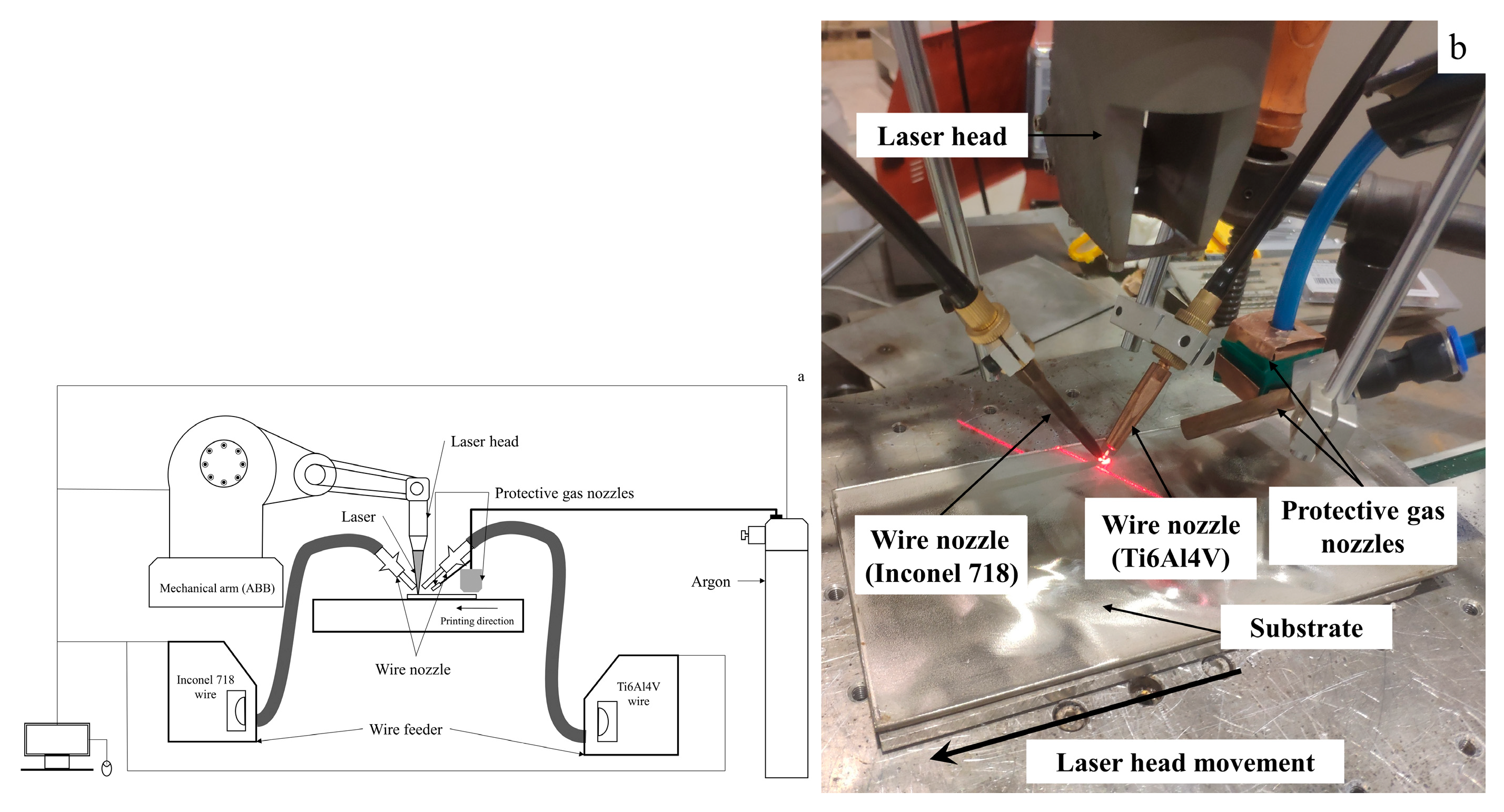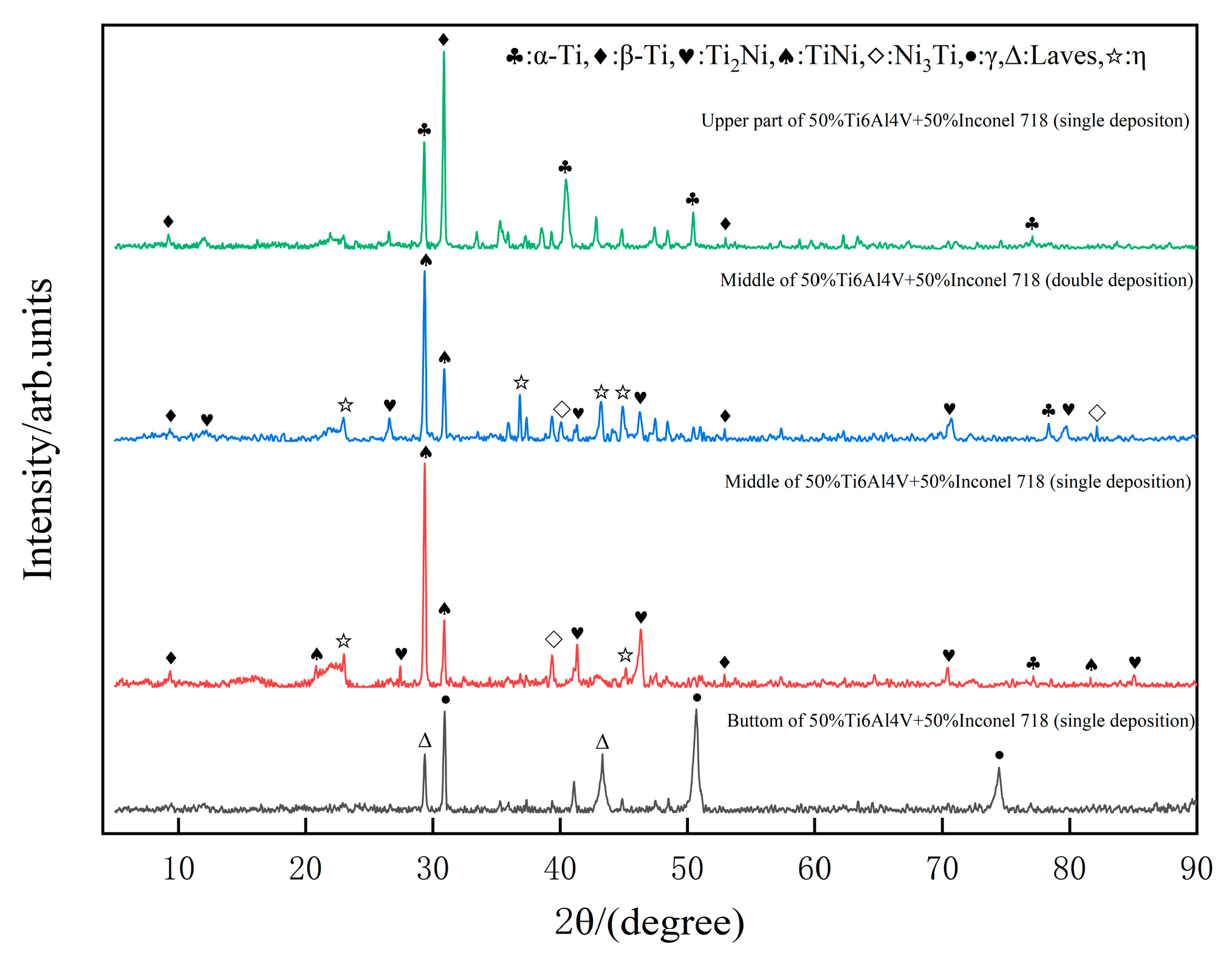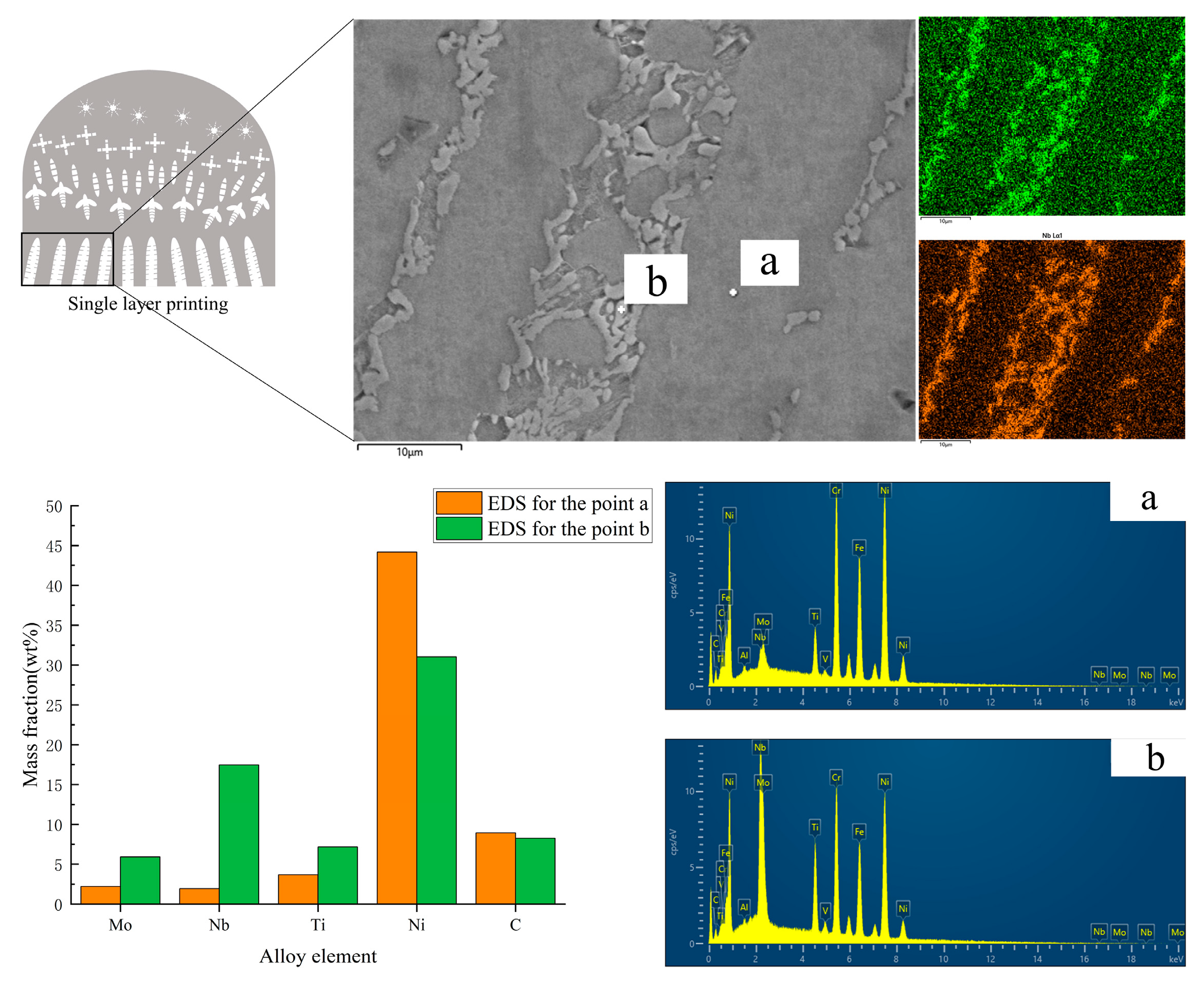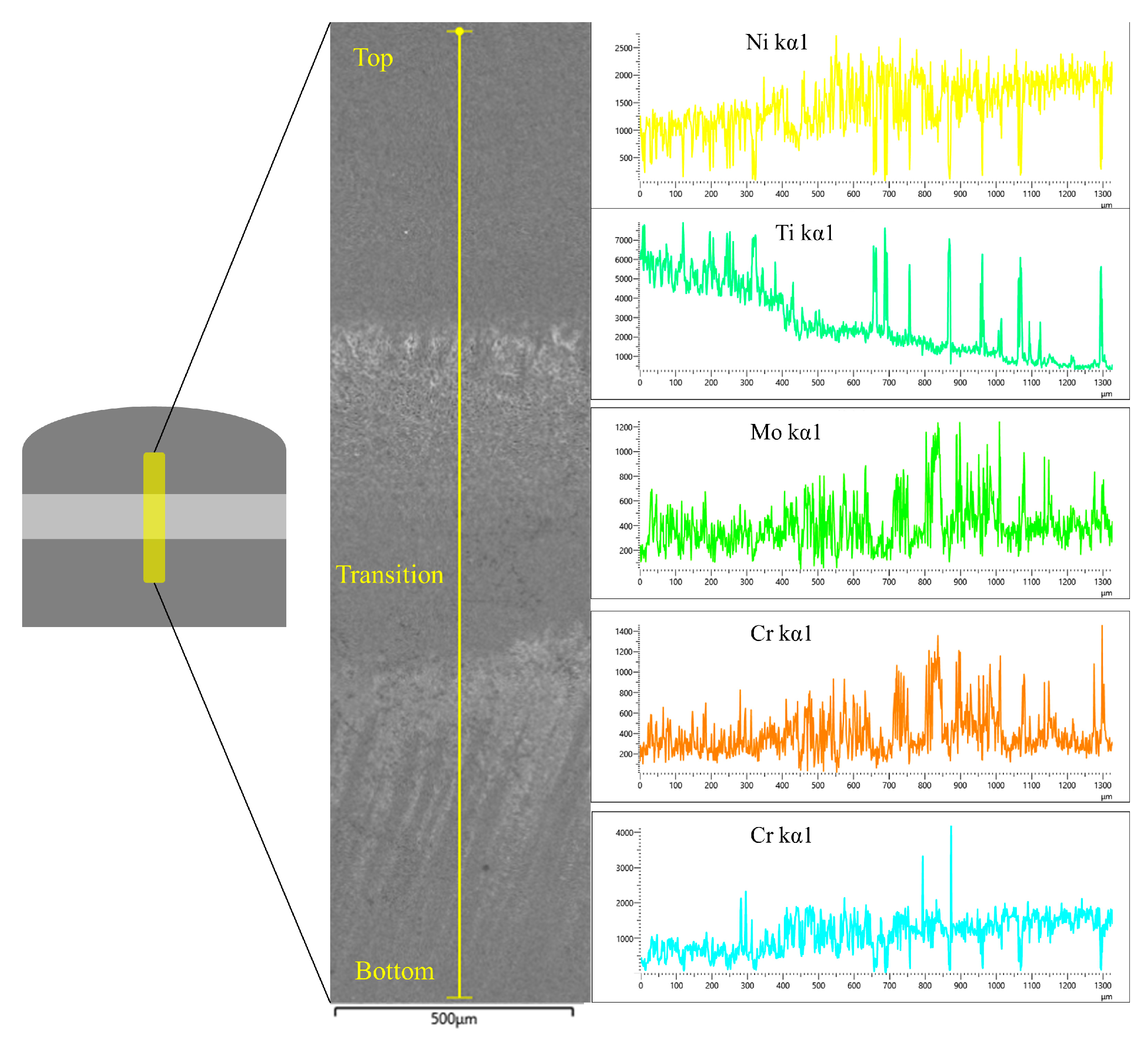Study of Phase Evolution Behavior of Ti6Al4V/Inconel 718 by Pulsed Laser Melting Deposition
Abstract
1. Introduction
2. Materials and Methods
2.1. Materials and Laser Processing
2.2. Wall Building
2.3. Sample Characterization Pre-Treatment
3. Results and Discussion
3.1. Microstructure Characteristics of Ti6Al4V/Inconel 718
3.1.1. XRD Phase Analysis
3.1.2. Optical Microscope Analysis of Microstructure Morphology
3.1.3. SEM Observation of Phase Transition
3.2. Effect of Compositional Changes on the Microhardness of Deposited Layers
4. Conclusions
- A new pulsed laser melting deposition technique was investigated. Based on this, Ti6Al4V and Inconel 718 with equal volume ratios in gradient materials were successfully printed and investigated.
- Cold cracking in the transition region due to Nb and Cr element bias enrichment during double-layer sample printing.
- The sample can be divided into three regions. The bottom region is Inconel 718 with columnar crystals as the main structure. The middle transition region is rich in secondary phases TiNi, Ti2Ni, etc., with cross and patterned morphology. The top of the sample has equiaxed crystals as the main microstructure.
- According to the hardness data, the maximum hardness of 951.4 HV was reached in the transition layer. The top part is second only to the transition zone in hardness due to the presence of equiaxed crystals. The bottom has the softest hardness with the lowest value of 701.4 HV.
Author Contributions
Funding
Institutional Review Board Statement
Informed Consent Statement
Data Availability Statement
Acknowledgments
Conflicts of Interest
References
- Muller, P.; Mognol, P.; Hascoet, J.Y. Modeling and control of a direct laser powder deposition process for functionally graded Materials (FGM) parts manufacturing. J. Mater. Process Technol. 2013, 213, 685–692. [Google Scholar] [CrossRef]
- Geng, Y.; Xie, W.; Tu, Y.; Deng, S.; Egan, D.; Dowling, D.P.; Song, H.; Zhang, S.; Harrison, N. Ti–6Al–4V microstructural functionally graded material by additive manufacturing: Experiment and computational modelling. Mater. Sci. Eng. A 2021, 823, 171782. [Google Scholar] [CrossRef]
- Chenglin, C.; Jingchuan, Z.; Zhongda, Y.; Shidong, W. Hydroxyapatite-Ti functionally graded biomaterial fabricated by powder metallurgy. Mater. Sci. Eng. A 1999, 271, 95–100. [Google Scholar] [CrossRef]
- Watanabe, Y.; Oike, S. Formation mechanism of graded composition in Al–AlCu functionally graded materials fabricated by a centrifugal in situ method. Acta Mater. 2005, 53, 1631–1641. [Google Scholar] [CrossRef]
- Zhou, M.; Xi, J.; Yan, J. Modeling and processing of functionally graded materials for rapid prototyping. J. Mater. Process. Technol. 2004, 146, 396–402. [Google Scholar] [CrossRef]
- Scaramuccia, M.G.; Demir, A.G.; Caprio, L.; Tassa, O.; Previtali, B. Development of processing strategies for multigraded selective laser melting of Ti6Al4V and IN718. Powder Technol. 2020, 367, 376–389. [Google Scholar] [CrossRef]
- Shah, K.; Haq, I.U.; Khan, A.; Shah, S.A.; Khan, M.; Pinkerton, A.J. Parametric study of development of Inconel-steel functionally graded materials by laser direct metal deposition. Mater. Des. 2014, 54, 531–538. [Google Scholar] [CrossRef]
- Bobbio, L.D.; Otis, R.A.; Borgonia, J.P.; Dillon, R.P.; Shapiro, A.A.; Liu, Z.K.; Beese, A.M. Additive manufacturing of a functionally graded material from Ti-6Al-4V to Invar: Experimental characterization and thermodynamic calculations. Acta Mater. 2017, 127, 133–142. [Google Scholar] [CrossRef]
- Koike, R.; Unotoro, I.; Kakinuma, Y.; Aoyama, T.; Oda, Y.; Kuriya, T.; Fujishima, M. Evaluation for mechanical characteristics of Incone1625-SUS316L joint produced with direct energy deposition. Procedia Manuf. 2017, 14, 105–110. [Google Scholar] [CrossRef]
- Meng, W.; Xiaohui, Y.; Zhang, W.; Junfei, F.; Lijie, G.; Qunshuang, M.; Bing, C. Additive manufacturing of a functionally graded material from Inconel625 to Ti6Al4V by laser synchronous preheating. J. Mater. Process. Technol. 2020, 275, 116368. [Google Scholar] [CrossRef]
- Sui, S.; Chew, Y.; Weng, F.; Tan, C.; Du, Z.; Bi, G. Study of the intrinsic mechanisms of nickel additive for grain refinement strength enhancement of laser aided additively manufactured; T.i.–.6.A.l.–.4.V. Int. J. Extrem. Manuf. 2022, 4, 035102. [Google Scholar] [CrossRef]
- Sui, S.; Chew, Y.; Weng, F.; Tan, C.; Du, Z.; Bi, G. Achieving grain refinement and ultrahigh yield strength in laser aided additive manufacturing of Ti−6Al−4V alloy by trace Ni addition. Virtual Phys. Prototyp. 2021, 16, 411–427. [Google Scholar] [CrossRef]
- Sofinowski, K.; Šmíd, M.; Kuběna, I.; Vivès, S.; Casati, N.; Godet, S.; Van Swygenhoven, H. In situ characterization of a high work hardening Ti-6Al-4V prepared by electron beam melting. Acta Mater. 2019, 179, 224–236. [Google Scholar] [CrossRef]
- Tan, X.; Kok, Y.; Tan, Y.J.; Descoins, M.; Mangelinck, D.; Tor, S.B.; Leong, K.F.; Chua, C.K. Graded microstructure and mechanical properties of additive manufactured Ti–6Al–4V via electron beam melting. Acta Mater. 2015, 97, 1–16. [Google Scholar] [CrossRef]
- Li, G. Study on Preparation of Surface Functional Structures on Metal Materials by Laser Pulses and the Effects on Their Properties. Ph.D. Thesis, Changchun University of Science and Technology, Changchun, China, 2022. [Google Scholar]
- Wang, C. Study on Microstructure and Properties of Transition Zone of TC4/Inconel 718 Bimetal Structure via Laser Additive Manufacturing. Master’s Thesis, Shenyang University of Technology, Shenyan, China, 2021. [Google Scholar]
- Mostafaei, A.; Zhao, C.; He, Y.; Ghiaasiaan, S.R.; Shi, B.; Shao, S.; Shamsaei, N.; Wu, Z.; Kouraytem, N.; Sun, T.; et al. Defects and anomalies in powder bed fusion metal additive manufacturing. Curr. Opin. Solid State Mater. Sci. 2022, 26, 100974. [Google Scholar] [CrossRef]
- Fu, X.; Wang, X.D.; Zhao, B.; Zhang, Q.; Sun, S.; Wang, J.J.; Zhang, W.; Gu, L.; Zhang, Y.; Zhang, W.Z.; et al. Atomic-scale observation of non-classical nucleation-mediated phase transformation in a titanium alloy. Nat. Mater. 2021, 21, 290–296. [Google Scholar] [CrossRef] [PubMed]
- Simonelli, M.; Tse, Y.Y.; Tuck, C. The formation of a 1 b microstructure in as-fabricated selective laser melting of Ti–6Al–4V. J. Mater. Res. 2014, 29, 2028–2035. [Google Scholar] [CrossRef]
- Meng, W.; Zhang, W.; Zhang, W.; Yin, X.; Guo, L.; Cui, B. Additive fabrication of 316L/Inconel625/Ti6Al4V functionally graded materials by laser synchronous preheating. Int. J. Adv. Manuf. Technol. 2019, 104, 2525–2538. [Google Scholar] [CrossRef]
- Dongjiang, W.; Shijun, Y.; Chao, Y.; Aidi, H.; Guangyi, M.; Fangyong, N.; Fan, L. Microstructure Evaluation and Mechanical Properties of Ti6Al4V/Inconel 718 Composites Prepared by Direct Laser Deposition. Rare Met. Mater. Eng. 2021, 50, 0078–0084. [Google Scholar]
- Jinxin, H.; Zhonggang, S.; Hui, C.; Lili, C.; Fei, X.; Lian, Z. Compositional Changes and Microstructure Evolution of Ti6Al4V-Inconel718 Functionally Graded Materials by Laser Additive Manufacturing. Rare Met. Mater. Eng. 2020, 49, 2813–2819. [Google Scholar]










| Al | V | Fe | C | N | H | O | Ti |
|---|---|---|---|---|---|---|---|
| 5.9 | 3.97 | 0.05 | 0.10 | 0.05 | 0.01 | 0.10 | Bal. |
| Ni | Cr | Nb | Mo | Ti | Al | Si | Fe |
|---|---|---|---|---|---|---|---|
| 53.61 | 18.76 | 4.86 | 3.12 | 1.05 | 0.49 | 0.18 | Bal. |
| Laser Power | Laser on Time | Laser Frequency | Arm’s Speed | Wire Feed | Wire Angle | Argon Gas Flow | Amount of Defocusing |
|---|---|---|---|---|---|---|---|
| 480 W | 8 ms | 20 Hz | 2.5 mm/s | 10 mm/s | 60~120° | 20/L·min−1 | +4 mm |
| Material | Melting Point/°C | Coefficient of Linear Expansion/ (10−6·K−1) | Thermal Conductivity/ (W·m·K−1) | Specific Heat Capacity/ (J·kg−1·K−1) | Density/ (g·cm−3) |
|---|---|---|---|---|---|
| Ti | 1677 | 8.2 | 13.8 | 539.1 | 4.5 |
| Ni | 1453 | 15.3 | 88 | 440.0 | 8.9 |
| Symbol | Ti | Ni | Cr | Mo | Nb |
|---|---|---|---|---|---|
| a | 97.44 | 0.80 | 0.28 | 0.09 | 0.45 |
| b | 60.07 | 22.61 | 4.91 | 0.33 | 1.16 |
| c | 46.68 | 25.92 | 9.29 | 2.67 | 0.89 |
Disclaimer/Publisher’s Note: The statements, opinions and data contained in all publications are solely those of the individual author(s) and contributor(s) and not of MDPI and/or the editor(s). MDPI and/or the editor(s) disclaim responsibility for any injury to people or property resulting from any ideas, methods, instructions or products referred to in the content. |
© 2023 by the authors. Licensee MDPI, Basel, Switzerland. This article is an open access article distributed under the terms and conditions of the Creative Commons Attribution (CC BY) license (https://creativecommons.org/licenses/by/4.0/).
Share and Cite
Wang, Y.; Ye, X.; Shi, M.; Pan, N.; Xia, P. Study of Phase Evolution Behavior of Ti6Al4V/Inconel 718 by Pulsed Laser Melting Deposition. Materials 2023, 16, 2437. https://doi.org/10.3390/ma16062437
Wang Y, Ye X, Shi M, Pan N, Xia P. Study of Phase Evolution Behavior of Ti6Al4V/Inconel 718 by Pulsed Laser Melting Deposition. Materials. 2023; 16(6):2437. https://doi.org/10.3390/ma16062437
Chicago/Turabian StyleWang, Yuanhao, Xin Ye, Mingli Shi, Nanxu Pan, and Peng Xia. 2023. "Study of Phase Evolution Behavior of Ti6Al4V/Inconel 718 by Pulsed Laser Melting Deposition" Materials 16, no. 6: 2437. https://doi.org/10.3390/ma16062437
APA StyleWang, Y., Ye, X., Shi, M., Pan, N., & Xia, P. (2023). Study of Phase Evolution Behavior of Ti6Al4V/Inconel 718 by Pulsed Laser Melting Deposition. Materials, 16(6), 2437. https://doi.org/10.3390/ma16062437






